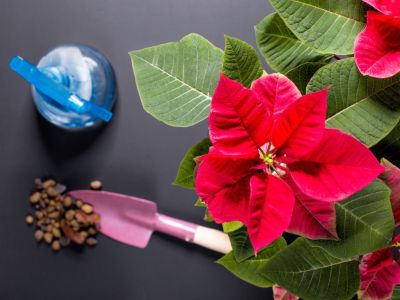How Much Water Do Poinsettias Need?
When it comes to watering poinsettia plants, too much is just as bad as too little. The best way to determine if a poinsettia needs water is to feel the top of the potting soil, which should feel moist and cool to the touch. If it feels dry, it’s time to water. Additionally, if the pot feels light as a feather when you lift it, the soil is too dry. The potting soil should be kept slightly moist but never soggy or dripping wet. To be safe, check the plant daily since potting soil can dry quickly in warm, indoor air. Soon, you’ll know how much water the plant needs without checking quite so frequently.
How Do You Water a Poinsettia Plant?
Check the bottom of the pot as soon as you bring the poinsettia home. If the pot doesn’t have at least one drainage hole, it’s critical to poke a hole as soon as possible. If the pot isn’t able to drain, the roots may rot fairly quickly. Additionally, the poinsettia will be happier if you remove any decorative foil, as the foil may hold water that can rot the plant. If you aren’t ready to rid the pot of its shiny wrapper, be sure the foil is completely drained after every watering. The best way to water a poinsettia plant is to put the plant in the kitchen sink, then saturate the plant slowly until water drips through the drainage hole. Let the pot stand in the sink until excess moisture drains, and then set the pot on a plate or tray. Never allow the pot to stand in water. Be sure to keep the poinsettia in a bright area where it receives six to eight hours of sun per day. Keep the plant away from heat vents and drafts, which can cause the leaves to drop.
